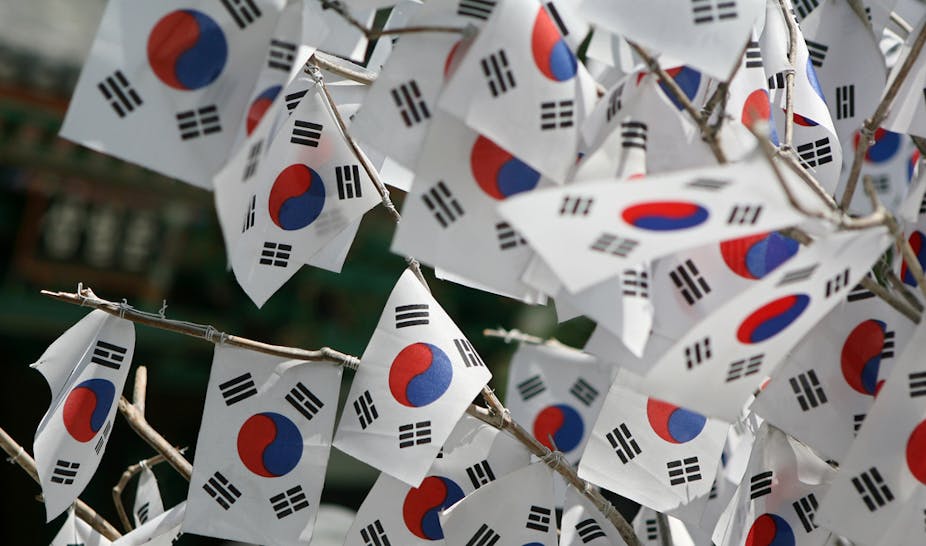Australia and South Korea are entering a Free Trade Agreement (FTA), but before you think “advanced Western country gains access to a large Asian market”, think again.
Economic powers have shifted seismically to the East Asian region (China, Hong Kong, Japan, Korea, Singapore, Taiwan), raising the question of who actually benefits from an FTA in the new world order, the so-called Asian Century.
China appears to be prioritising its Asian neighbours, including South Korea, over Australia, despite Prime Minister Tony Abbott’s ambition to have an FTA signed with China by the end of the year.
South Korea is more competitive
Korea has surpassed Western economies on most key economic dimensions. In the 60 years following the Korean War, the southern part of the Korean peninsula has become one of the most dynamic and sophisticated economies in the world, whereas in contrast, Australia’s competitiveness has dropped, and falls short on key macroeconomic dimensions.
According to the World Economic Forum (WEF), Australia ranks 21st in terms of global competitiveness, Korea ranks 25th. But in terms of innovation and sophistication, Korea is 20th and Australia 26th, in terms of infrastructure Korea ranks 11th and Australia 18th; for the macroeconomic environment it’s 9th versus 25th, and for health and primary education, Korea ranks 18th, Australia 22nd.
Nevertheless, some Australian industry sectors are strong and globally competitive. For example, agriculture will benefit from the FTA with growing beef, dairy, sugar, wheat and wine exports to Korea once tariffs fall. But at the same time, Korea’s own food industry has fast reached global centre stage with innovative noodle, confectionery and healthy herbal products, whereas Australian processed food may find only little demand in Korea. Australia can position itself to deliver raw materials for the Korean food industry, but Korea is also looking to China for produce more in line with local tastes such as rice and herbs.
Manufacturing in a spiky world
Korea is a world leader in the manufacturing of high-tech products such as mobile and smart phones, tablets and smart TVs (Samsung, LG), whereas Australia is not involved in making such things. At the same time, Korea hosts two of the most dynamic and profitable, fastest growing car manufacturers: Hyundai and Kia.
Korean manufacturers are smart in utilising comparative advantages on a regional, if not global scale. Design (R&D) and marketing of such products is largely done in Korea, but the labour-intensive manufacturing has partially been outsourced to low-cost countries such as Indonesia and Malaysia (electronics), Vietnam (tyres) and India (cars).
The Australian car industry has, in contrast, not only lost foreign brands such as Ford, Mitsubishi and Toyota, but even its own home-grown brand Holden has defected from Australia for more cost effective manufacturing in - you guessed it - Korea.
Toyota’s management made a point of mentioning tariff issues when they made the decision to pull out of Australia, but in fact such large scale decisions are more of a competition issue rather than a tariff one, which is really about market access. Ultimately, Australia may simply not have a comparative advantage when it comes to (car) manufacturing, and in the global car industry, manufacturing moves to locations with the greatest competitiveness.
Australia may gain a synchronous advantage, however, once tariffs on steel are reduced and more Australian gear boxes are shipped to Korea. The Korean car industry benefits from that revised trade too, and subsequently is able to sell more cars, which in turn means Australia can make more gear boxes for more Korean cars. This will result in a symbiotic advantage because both countries win in international trade.
Korea wins on services and education too

In addition to manufacturing, Korea has emerged as a strong service provider with competitive airlines and a growing tourism sector.
The FTA will guarantee market access for education providers, but here too, Korea is fiercely competitive. Korea’s education system with a focus on academic performance, discipline and passing on Confucian values has resulted in strong PISA results.
Korean students outperform Australian 15 year olds by 10% in maths and 6% each for reading and science. The Australian government aims to lift education to East Asian standards as part of the Asian Century theme, but the Confucian approach to education took centuries to form, and is not a matter of simply “copy/paste”.
Korean parents are still sending their offspring to study down under, but Korea is increasingly attracting international students itself.
The big challenge for Western countries such as Australia is that education ultimately leads to competitiveness, and if the gap between East Asian and Western education standards and performance widens more, then by the very logic, global competitiveness of East Asian nations like Korea will further increase, and Western countries will have a less globally competitive workforce.
Where Australia can benefit
Korea will continue to be hyper competitive with fast to market products and services, it will continue to pass on Confucian dynamism in its education system, and it will focus on FTAs more important than the one with Australia.
Korea, together with China and Japan, make up 20% of the global GDP, and if territorial disputes can be overcome, then these three countries will likely enter FTAs and compete on equal footing with the USA and European Union; Australia may be a niche player in contrast.
It would be naïve to assume that Australia can in fact compete with Korean brands such as Hyundai, Kia, or Samsung and LG. The benefit of the new FTA for Australia is not merely the opening of an already key export market, but a chance to learn from Korea about an education system that contributes to a competitive workforce, an opportunity to better understand the utilisation of comparative advantages, and in the longer term, a chance to regain global competitiveness.

